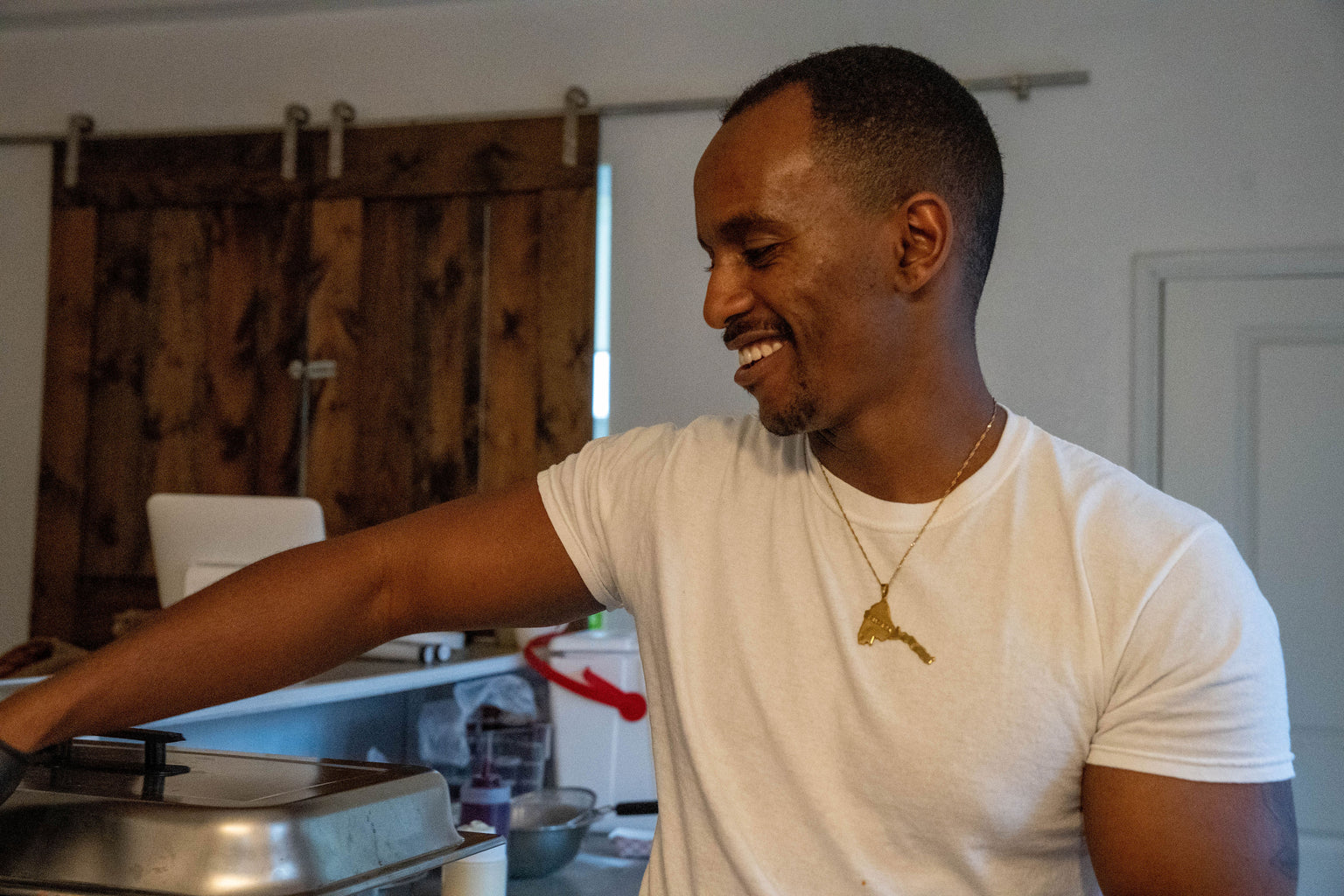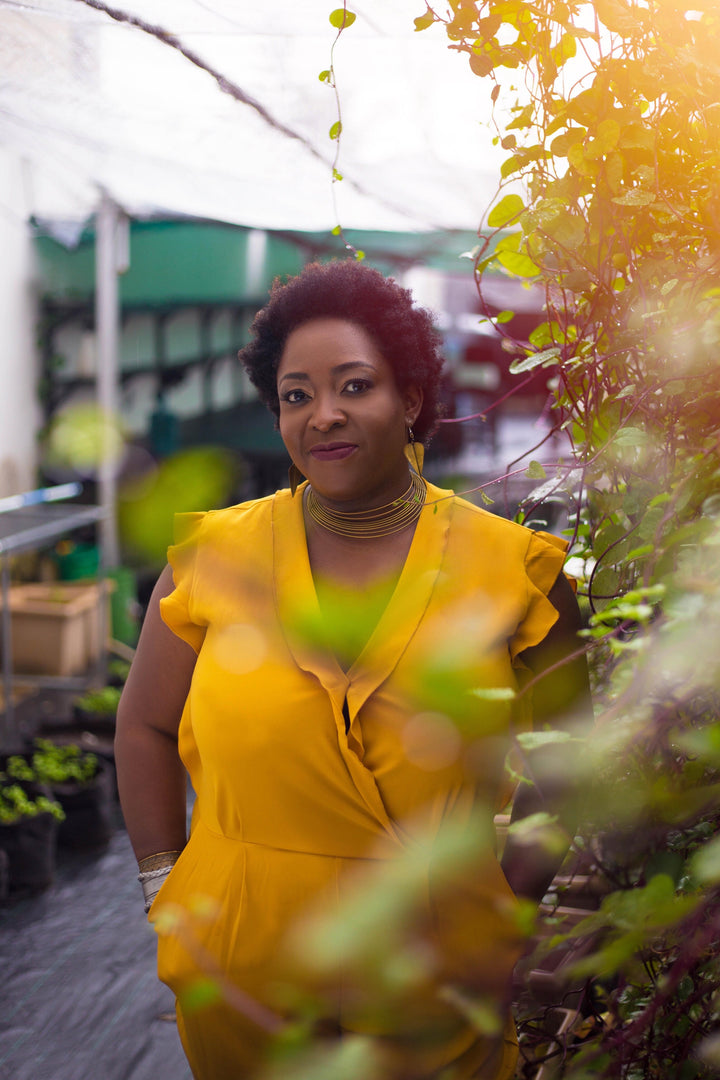Let's Talk East African flavors and Afro-Fusion Cooking with Khalieb!

Written by: Bethany
Born in Louisville to a mom from Kentucky and a father from Eritrea, Khalieb Rufael is a professional cook who considers himself “a mixed child” allowing his blend of cultures influence his cooking. He has had an extremely interesting journey forging his path into the culinary world from starting off in kitchens working unpaid, moving to France for some months to immerse himself in French food and agriculture while getting some more training then finally coming back home to Houston, Texas where he now focuses on catering and Afro-fusion pop-up events.
In a time like now, where African music, clothing & food are coming to the forefront, I can’t help but notice that a lot of the attention is on West Africa and dare I say Nigeria to be specific. The African continent as a whole is so rich in cuisine, and I know it’ll be a great disservice to only limit my experiences to West African foods.
I’ve personally tried East African food two twice, the second time being with Khalieb at a restaurant here in Houston that serves Ethiopian food, and it was a great experience. Of course that’s not where I plan to end my interaction with east African food, I still have so much ground to cover but I feel this conversation with my American-Eritrean buddy is a nice and gentle start.
Bethany Oyefeso: How do you stay connected with Eritrean food as someone that has such a diverse background ?
Khalieb Rufael: There are a couple of ways that I try to stay as connected as possible to my community. One way is to really go to the nearest restaurant. If I can recommend anybody who's having trouble or who would like to get more connected with their community, or with East African food, I would say go to the restaurants, go to the grocery stores. This is what I like to do. I go and get fresh ingredients because there are certain ingredients that are very specific to Eritrean culture, just like there are certain ingredients that are very specific to Nigerian culture. For East African culture, there's a butter called Tesmi which is like ghee, but it's infused with spices and that's one thing that you'll never be able to find at any grocery store besides the Eritrean or Ethiopian grocery store so that's what I do to pretty much stay connected to the ingredients.
Another thing is Instagram. I found out there's so many resources on Instagram and on YouTube and online as far as finding recipes and people who are developing recipes, people who are in Ethiopia and Eritrea making food content, and they're more than willing to connect and to share with anybody who's interested. That's another way that I'm able to stay connected to my culture, my roots in food.
Bethany Oyefeso: I like how you brought up the point about actually following creators and people who are actually in those places because they're the ones that have the most access to the ingredients and to the recipes. There's actually no better place to learn than from the people on ground. What is a traditional Eritrean dish that you think everyone should try first?
Khalieb Rufael: Okay, it really depends on who it is that we are trying to introduce this to. This is the thing the American palate is different from, for example, the West African palette. It's two different things. The way that we enjoy our proteins, the way we enjoy our carbs can be very different. I'll say as far as Americans go, the one dish that I would like to introduce them to first would probably be Tibs. Tibs is pretty much a stir fried beef dish, and the beef isn't cooked well done. It's not like undercooked, but it's more so medium, medium- rare. It can be small pieces of beef, stir-fried in Tesmi. You remember the infused butter that I was telling you about, jalapenos, tomatoes, and onions. It's served on Injera, which is the National Bread of Ethiopia and Eritrea.
If we're talking about other cultures like West Africa, the first dish I would introduce a West African to is Doro Wat. Doro Wat is, I think, the national dish of Ethiopia. It's pretty much stewed chicken with eggs, stewed down with a lot of red onions, and cooked caramelized. Berbere is a blend of 27 different spices, mainly exported from Ethiopia, and Tesmi, the butter, then there's usually red wine or beer to braise, and it's very delicious. If I could compare it to anything, it'd probably be red stew, but usually not as spicy and also has eggs and whole pieces of chicken. The technique to cooking it is very different, but it whenever you eat it, it's similar to that and, of course, you'll eat that on injera and enjoy that with your hands.
We talked about his participation in the Oxtail Mashup 2022 and how he came in second place competing against 17 top chefs from not only Houston, but outside of the state too and the winning dish was a fusion dish.
Khalieb Rufael: “I made an Oxtail Zigni and Zigni is the tigrinya word, which is the language of Eritrea. It's the tigrinya word for beef stew. I took the oxtails, I stewed them down with lots of onions, lots of bullion, lots of berbere, bay leaves stewed down till tinder and then plated it on top of injera that I cut to where it's like a small taco type of thing with a roasted garlic aioli, some toasted sesame seed, and a pickled Fresno chili for a little bit of spice. Yeah, that one won me second place in both categories of Oxtail MashupI was pretty proud of that accomplishment.”
This opened up another conversation around my current thoughts surrounding fusion dishes as a way of introducing others to one's traditional cuisine.
Bethany Oyefeso: Over time, my thoughts and opinions about Afro Fusion have changed a little bit truthfully. I've lived in Houston, Texas, for almost 16 years now, actually, but I was born and raised in Nigeria and in the beginning of my cooking journey, I always wanted to do fusion dishes because I lived in many places. I've lived in a couple different countries now and I felt that because I love so many flavors that are not just Nigerian only, I would like to kind of celebrate all the flavors and all the dishes that I like, but over time, as I started wanting to introduce people to my foods, I started being of the opinion that I don't necessarily have to “water down” or fuse my foods with something that is more palatable to the west in order for me to introduce it to them. It's nice to have fusion dishes. I will love fusion dishes forever because the flavors are on a different level, but I'm not talking from a flavor perspective right now, I'm talking from an introduction of your culture to others. Being both American and Eritrean, would you say that in order to be able to introduce people to your cultural foods that you have to do fusion dishes or did fusion dishes become a thing for you as a result of not being from only one place and wanting to represent both sides?
Khalieb Rufael: Wow, that's a good question. You also gave me a lot to think about because I often will try and take dishes from my country to try and help people understand what's going on when I say Zigni, and I say Doro Wat by trying to put it on a taco or on a sandwich or with rice or whatever, even though that's not typically how we how we enjoy our food.
To answer your question, I don't feel as though we need to water it down if that's how you want to describe it. I don't feel like we need to do that at all. I feel as though there's a lack of education, and there's a lack of representation. I take the responsibility for teaching people and I take the responsibility for educating people about my country and about the food of my country. I think if I can spread more words, if I can educate more people about it, then there'll be less need for the fusion aspect of things. I think fusion is good for that reason that it gets people to say, "I've tried it." I've tried Eritrean food in this aspect, so maybe now I'd be willing to go to an actual Eritrean restaurant and sit down with Injera and eat with my hands.
It's good for introducing and warming people up because the American palate is one that can be sometimes hard to break down but when it comes to educating, and when it comes to to teaching people about what it is that we do, how we prepare foods, how we cook our foods, how our foods are supposed to taste, I don't think that that fusion is really necessary, but like I said, it's got its benefits so whenever it's a tough crowd, you're trying to warm people up, you know, especially when you're in a situation where you're selling food, it's difficult to sell people an experience.
Bethany Oyefeso: Yeah. I completely understand you. Especially when you're starting out too, you have to find a way to kind of just enter first. And then when you do, you can become a little bit more dominant about how you want to run your things. Fair enough. Okay, I'll give you a pass. As you mature as a chef, are you leaning more into Eritrean dishes, or you’re going to continue to keep it diverse the way you’ve been?
Khalieb Rufael: Definitely, I'm falling in love, more and more every day with Eritrean food. More and more in love with the food of Ethiopia and Eritrea. The more that I learn, the more I know about myself and the more I know about my family and about my people and by knowing more I can help more people and influence more people. I'm definitely falling head first into Eritrean food but a little bit into Italian food as well.
For those who don't know, Eritrea was colonized by Italians and because of that influence that they left whenever my grandfather escaped from Eritrea as a refugee he and his family, my aunts and uncles fled to Italy and that's where they have been located ever since. I've taken multiple trips to Italy to visit my family, and because of that, the influence of Italian food definitely comes through in my cuisine. I love Italian food, everybody loves Italian food, so I'll say, I'm falling into Eritrean food more and more, but also keeping in touch with The Italian influence that is very present in Eritrea.
Bethany Oyefeso: Wow, it's so crazy how much history there is behind food and food cultures and the way people just interact and engage with food. Sometimes I feel like people that are not really into food, just look at food as a source of energy to just stay alive but there's so much depth and there's so many layers that come with food.
We chatted a little bit more about how he’ll continue building his relationship with Eritrean food, and I asked him what his favorite comfort dish is and some ingredients typically used in Eritrean cooking. He also shared a little bit about how socioeconomic factors play a role in the East African diet.
Khalieb Rufael: Ful is my comfort food. Ful is typically a brunch - breakfast type of dish. It is fava beans that have been cooked and marinated and mashed.That's the base of the dish. It's mainly fava beans that have been cooked down with these onions, and garlic, and, and spices typically served with fresh bread. If you have something like naan, or baguette, or even sourdough, It really doesn't matter the bread you could even use English muffin. We typically use baguettes when we eat food here at the house. Fresh tomatoes, fresh onions, fresh jalapeños, sometimes cilantro, sometimes boiled egg and olives. Those are just the toppings that you add to your fava beans, and you use the bread to kind of scoop up your beans dressed with a little bit of lemon juice. It’s really, really good and it's healthy like a lot of Ethiopian and Eritrean food. It's vegetarian or vegan if you don't add the feta cheese, but it's very healthy, very delicious but not like, you know, sacrificing deliciousness for healthiness. It's one of my preferable vegan vegetarian dishes.
Bethany Oyefeso: What would you say are the top four or five ingredients that you would see across the board?
Khalieb Rufael: The top four ingredients. Definitely Tesmi, the ghee infused with spices. Berbere. Of course, you have to have Berbere. Another ingredient would be cardamom. We use a lot of cardamom to spice our dishes. Sometimes, we just use straight fresh cardamom, and we usually grind it ourselves. Also, we use a lot of lentils for a lot of different dishes.
Bethany Oyefeso: Would you say generally, east African cuisine is mostly vegetarian and not carb heavy?
Khalieb Rufael: Mmm. Definitely not meat heavy for sure because, I mean, Eritrea was the third poorest country in the world not too long ago. This means that if you have goats, you have cows, you're not trying to eat that animal. You're using it to sustain your family and your life. So when you do eat meat, it’s only on holiday and very special occasions. When it comes to cows and goats like that, especially from the perspective of somebody like me, who's raised in the US, we see cows and we're like, Oh, that would make a great steak and that's all we can pretty much think of from that point. But from somebody from that perspective, no, that cow is providing milk, cheese, and fertilizer for my plants so I can grow vegetables.
There are a lot of different resources that cows provide, and that livestock in general provides for people. So meat is not at all something that's consumed on a daily basis. But I would say carbs, mmm, we do eat a lot of injera. The Italian influence allows us to eat a lot of pasta and a lot of bread. If anything, bread is what we eat a lot of, but not a lot of rice. Not a lot of rice, not a lot of meat either.
He also talked about a dish that every Eritrean home will always have.
Khalieb Rufael: Shiro is ground chickpeas. They take chickpeas, they dry them out, they grind them to a powder, and then add in spices and whatnot and then cook that with a little bit of water. It's kind of like the way you cook grits. You boil water, then you whisk in the powder, and it turns to porridge, and we eat that within injera, and that's considered to be like what you call a poor man's meal. when you don't have anything at home, you actually do have something at home, you always have shiro at home.
Bethany Oyefeso: That meal after you’ve just paid rent.
Khalieb Rufael: Yes! When you ask your mom, can we get McDonald's? And she’s like, No, we actually have Shiro at home, you know?
Bethany Oyefeso: thank you so much for bringing that up.
Before we wrapped up, I asked him about his first interaction with Eritrean food here in the U.S, what he ate and how old he was.
Khalieb Rufael: Oh my gosh, this is so embarrassing because we were just talking about fusion food. I was five or six at the time, my dad was having trouble getting me to eat zigni and I was like “Yeah, I'm not eating that. It's not a hot dog. It's not grilled cheese.I'm not taking that down” but what he did was take the zigni, and two pieces of white bread and make a Zigni sandwich. So we're talking about fusion foods, that's when I got my first bite and I was like, Wow, that is freaking good.
Bethany Oyefeso: Wow. Okay. Well, I understand what you're saying about introducing a dish through fusion.
Khalieb Rufael: Literally. Yeah. Sometimes you just gotta give it to people the way that looks familiar and then they'll be more willing to try and they'll probably really enjoy it and give it a chance.
Follow Khalieb’s Work
You can follow and check out Khalieb's work on Instagram.



